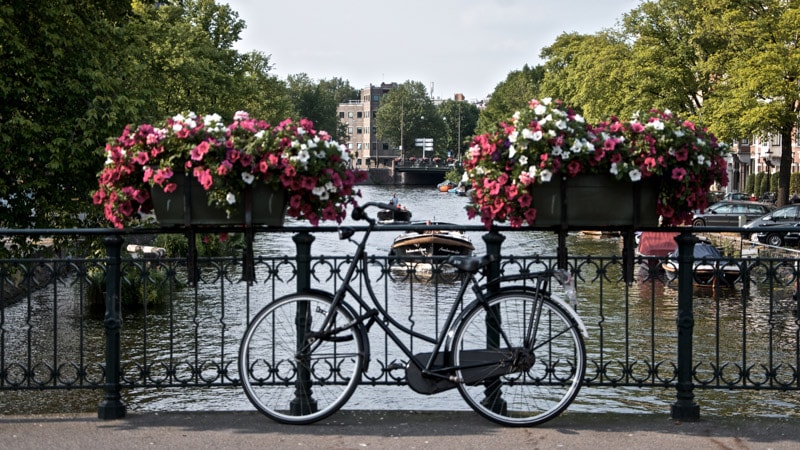
Here are some cool facts about Amsterdam that you might not know. Facts about bikes, canals, museums, and single tulip bulbs that once cost over $200,000.
Table of Contents
1 – Amsterdam lies below sea level
Amsterdam, and even half of the Netherlands, lies below sea level. The city, built upon lakes, swamps, and peat, is located about 6.5 feet (2 meters) below sea level. The lowest point in Amsterdam is a whopping 21.9 feet (6.7 meters) below sea level.
An extensive network and system of sea dikes, sand dunes, dams, and floodgates keep Amsterdam, and much of the Netherlands, from completing flooding. The system is strong enough that developers claim only a 1 in 10,000 year storm could bring down the sea dikes. Let’s hope they are right.
2 – Amsterdam Stock Exchange is considered to be the world’s oldest stock exchange
If you think the London Stock Exchange, founded in 1801, is the oldest stock exchange in the world, then you are mistaken.
The Amsterdam Stock Exchange was founded by the Dutch East India Company over 400 years ago. It was founded in 1602, which many argue to be the oldest stock exchange in the world.
3 – There are more bikes than people in Amsterdam
The population of Amsterdam is around 825,080. With an estimated 881,000 bikes in Amsterdam, there are more bikes in the city than residents.
About 60% of citizens are believed to use their bike on a daily basis along some of the 310 miles (500 kilometers) of bike paths.
So next time you are walking around Amsterdam, keep an eye out for all those bikes whizzing by.
4 – There are 75 museums
With 75 museums, Amsterdam has the highest museum density anywhere in the world. Many of these museums are located on Museumplein (Museum Square).
Some of the most well known museums in the city include the Anne Frank House, Van Gogh Museum, and Rijksmuseum.
If you stop by the Rijksmuseum, be sure to check out the large collection of classical Dutch art including the famous painting The Night Watch by Rembrandt van Rijn.
5 – English is an official language
Dutch may be the national language of the Netherlands, but English is also an official language.
Almost everyone in Amsterdam speaks English so you will have no problems communicating with the locals when trying to order that food or drink.
6 – Amsterdam is one of the most culturally diverse cities in the world
Amsterdam prides itself on being an open and tolerant society. After World War II, people from all over the world immigrated to Amsterdam to live a better life.
Today, Amsterdam is a culturally diverse city home to at least 178 different nationalities! Over the years, these immigrants have introduced new religions, cultures, and delicious new foods.
One of my best restaurant experiences in Amsterdam was when I had Thanksgiving dinner at a Dim Sum restaurant in the Red Light District.
7 – There are more canals in Amsterdam than Venice
It might be surprising to some, but Amsterdamn has more canals than Venice. Amsterdam has 165 canals while Venice is just behind with 150 canals.
With so many canals, Amsterdam has been nicknamed “Venice of the North.”
Part of the Canal Ring in central Amsterdam, built in the 17th century, was added to the UNESCO World Heritage List in 2010.
8 – There are over 2,500 houseboats in the city
Floating in the canals of Amsterdam are over 2,500 houseboats which have become somewhat of an icon of the city.
Many of these houseboats have been converted into floating hotels for those who want to experience what it’s like to stay on a houseboat.
For those who love animals, especially cats, check out the unique “De Poezenboot.” Also known as the Cat Boat, this houseboat turned cat shelter houses over 50 stray and abandoned cats in need of help. Today, the Cat Boat is a major tourist attraction.
9 – Amsterdam is the 12th most visited tourist destination in the world
With 7.23 million tourists in 2014, Amsterdam has become the 12th most visited tourist destination in the world.
In Europe, Amsterdam is the 5th most visited city behind London, Paris, Istanbul, and Barcelona.
10 – Tulipomania was the world’s first economic bubble
In the middle of the Dutch Golden Age during the 17 century, Amsterdam witnessed the world’s first economic bubble.
The prices of single tulip bulbs reached extraordinarily high levels which just as quickly collapsed. This period in history is known as Tulipomania.
At the peak of Tulipomania in late 1637, single prices of bulbs skyrocketed to as high as 1,000 florin, or over $200,000 in today’s dollar.
Many made large fortunes buying and reselling tulips. By early 1637, the demand and prices for tulips collapsed. Many tulip speculators lost their entire fortune.
Last Updated on March 26, 2024
Related Posts